Page 1 of 1
Tube-dwelling diatoms
Posted: Mon Jul 04, 2016 8:42 pm
by c-krebs
Whenever collecting marine specimens (or in rapidly moving fresh water) I always keep an eye out for what looks like a very delicate brown alga. Under the microscope this alga sometimes turns out to actually be tube dwelling diatoms. The diatoms live in tubes of mucilage. I find it fascinating how these pennate diatoms have devised a way to live in active waterways where they would otherwise be swept away. They're fun to observe. They usually move about slowly and regularly, reminding me of an aerial view of cars on a congested freeway.
About a year ago I can across a nice clump of these diatoms, and worked up some pictures (that were posted elsewhere

) Seeing the interest in diatoms here, I revisited that photo session from last summer and worked up some new (albeit similar) images. These are a marine species collected in Puget Sound WA. (47.589868° -122.379828°)
The first is darkfield, the other four are DIC. All with electronic flash.
More info on these diatoms:
http://university.uog.edu.172-31-22-36. ... ellers.htm
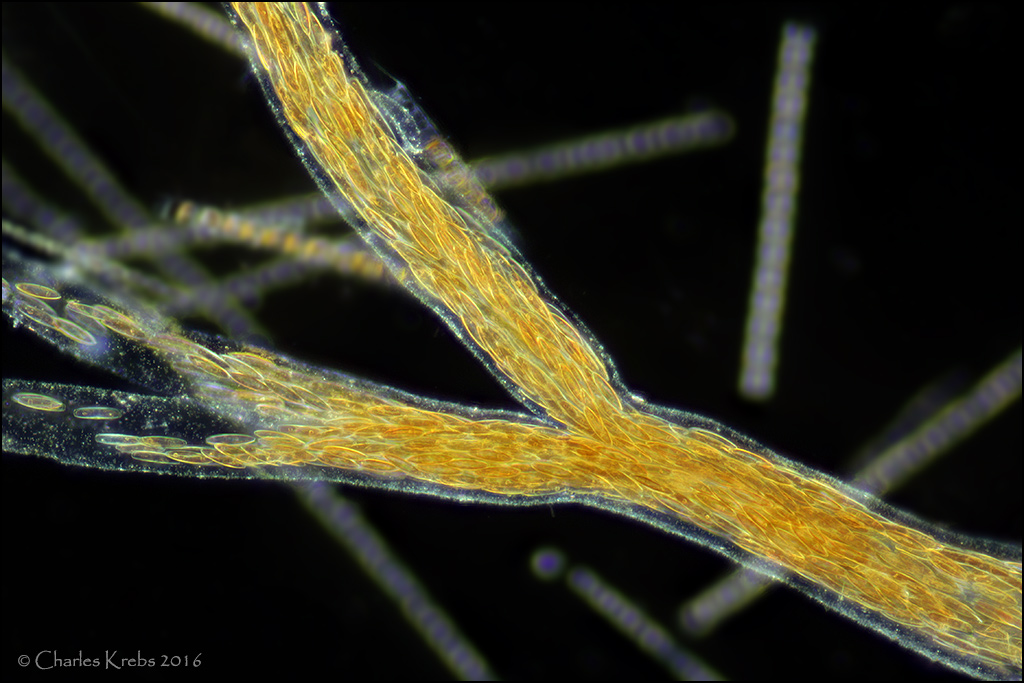
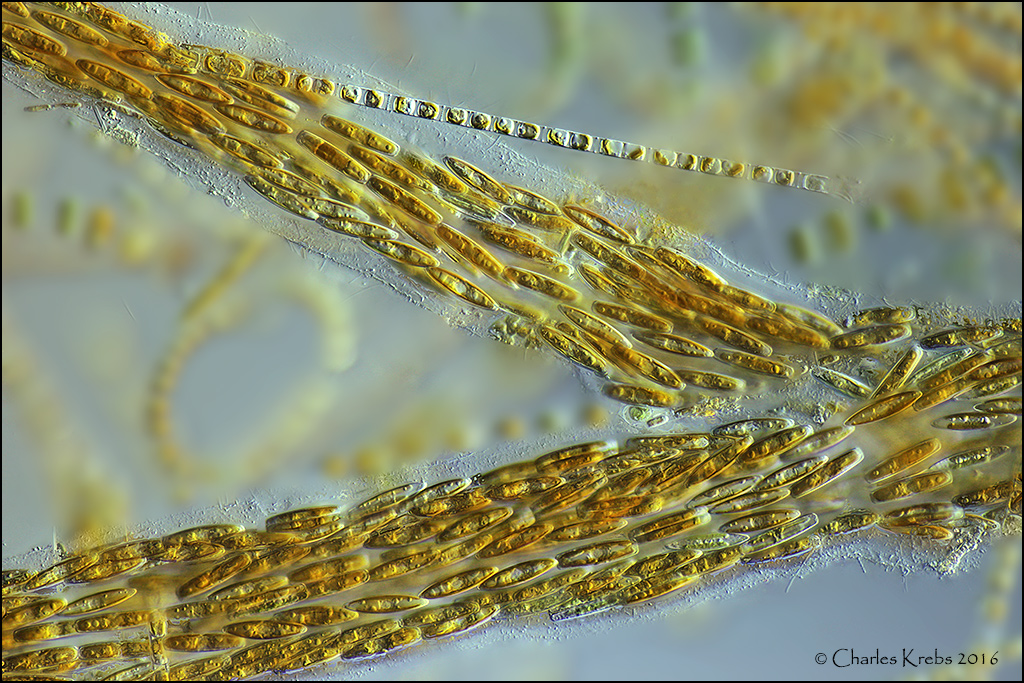
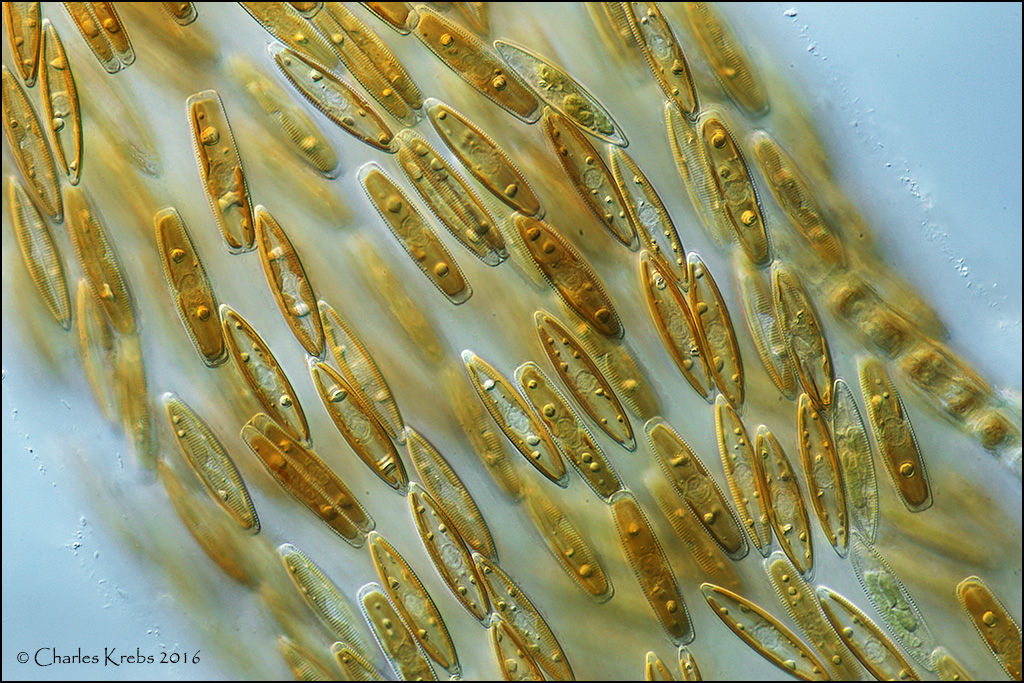
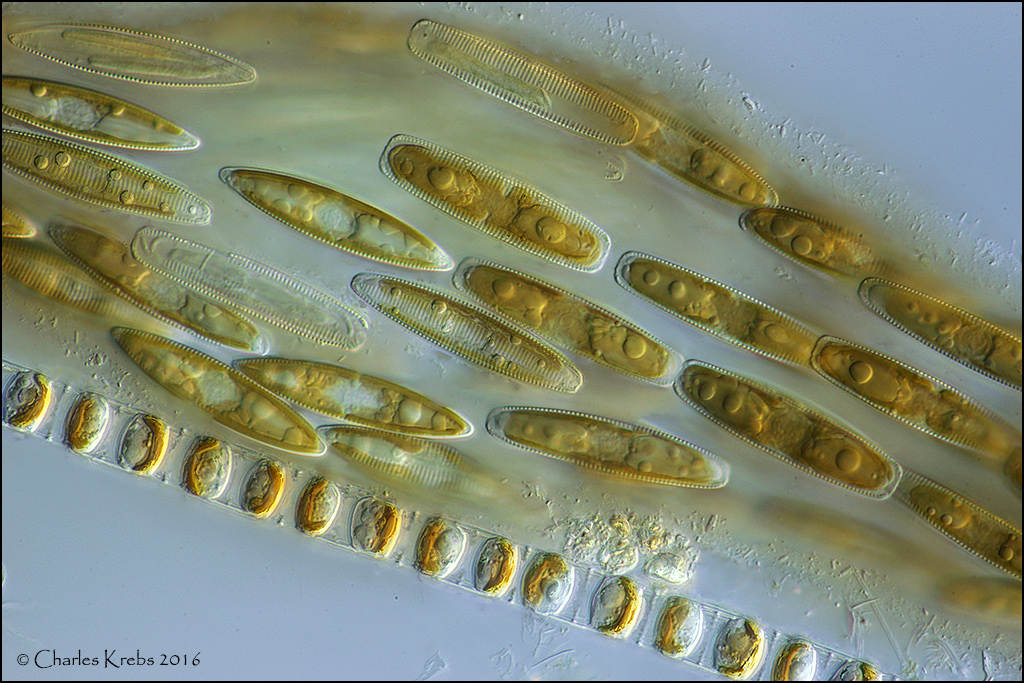
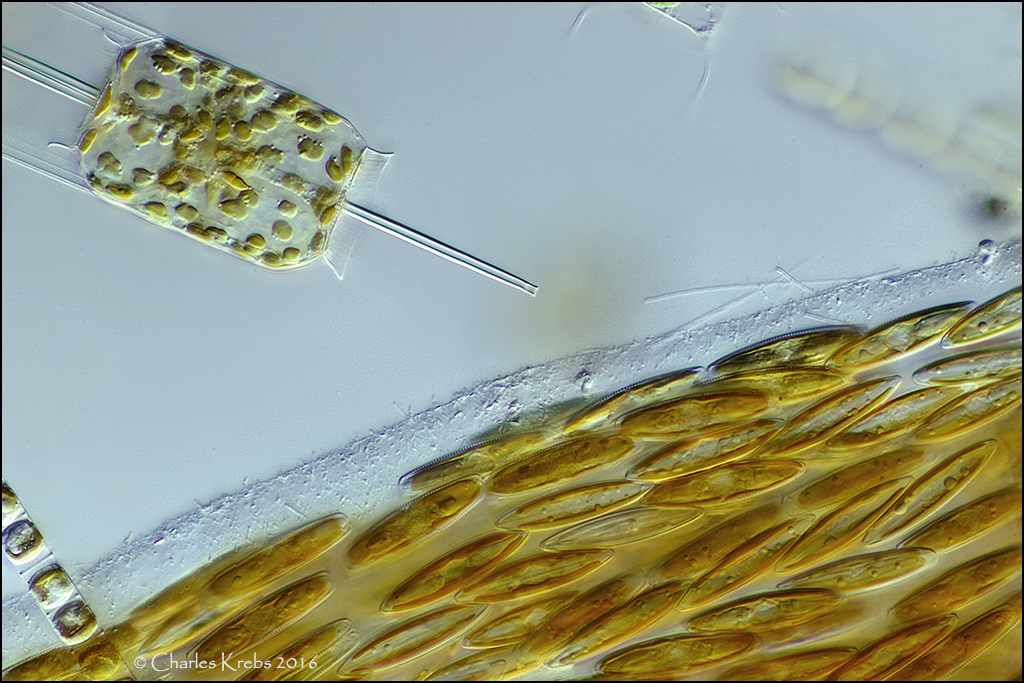
Re: Tube-dwelling diatoms
Posted: Mon Jul 04, 2016 9:22 pm
by 75RR
I am continuously surprised by diatoms! Beautiful images. What is that in the top left corner of the last image?
Re: Tube-dwelling diatoms
Posted: Mon Jul 04, 2016 9:25 pm
by billben74
Wow. Really lovely stuff.
I've seen moving diatoms and they do have a lovely slow kind of motion. And I can see how they must have looked just as you said.
Do you know what the syringe-like (or perhaps one of those thistle pieces of glassware) thing is with the algae(?)on the last image is?
Also what objectives are you using here?
Again, thanks for the beautiful images.
Re: Tube-dwelling diatoms
Posted: Mon Jul 04, 2016 9:27 pm
by billben74
Sorry 75RR and Charles.
I had started writing prior to 75RR's post.
But, hey great minds think alike?
Re: Tube-dwelling diatoms
Posted: Mon Jul 04, 2016 9:55 pm
by zzffnn
Very beautiful!
Re: Tube-dwelling diatoms
Posted: Mon Jul 04, 2016 10:10 pm
by billbillt
The most beautiful diatom photos ever...
BillT
Re: Tube-dwelling diatoms
Posted: Mon Jul 04, 2016 10:34 pm
by c-krebs
Thanks all!
In the upper left hand corner of the last image is the marine diatom Ditylum brightwellii. (They always remind me of some sort of "communication satellite" floating in space

).
Re: Tube-dwelling diatoms
Posted: Tue Jul 05, 2016 12:07 am
by KurtM
Absolutely wonderful stuff! I am in awe of the sharpness and clarity -- is it safe to assume these images are stacks? My little dabblings with stacking using Combine ZP and Picolay have been pitiful, is there a good discussion on better stacking software and/or techniques you can point me to? Thanks!
Re: Tube-dwelling diatoms
Posted: Tue Jul 05, 2016 12:21 am
by rnabholz
Hey Charles,
I have encountered tube dwelling diatoms in live samples, and they are always a treat to find. I have not seen the species that you have so beautifully captured, at least not in the tube, but your images make me feel like I have.
Thanks for posting!
Rod
Re: Tube-dwelling diatoms
Posted: Tue Jul 05, 2016 1:15 am
by Rodney
You do incredible work C.K., lots of talent around this forum for us to admire.
Rodney
Re: Tube-dwelling diatoms
Posted: Tue Jul 05, 2016 1:57 am
by JimT
I have gained a totally new appreciation of diatoms. I liked them to start with but you images just blew me away.
A congested highway at rush hour is a good way to describe them.
Beautiful!!!
Fill us in on the obj's used.
JimT
Re: Tube-dwelling diatoms
Posted: Tue Jul 05, 2016 3:07 am
by zzffnn
KurtM wrote:Absolutely wonderful stuff! I am in awe of the sharpness and clarity -- is it safe to assume these images are stacks? My little dabblings with stacking using Combine ZP and Picolay have been pitiful, is there a good discussion on better stacking software and/or techniques you can point me to? Thanks!
Kurt,
Charles talks about stacking briefly in this video:
https://www.youtube.com/watch?v=9MMVMPDI4CE
Re: Tube-dwelling diatoms
Posted: Tue Jul 05, 2016 3:14 am
by c-krebs
JimT wrote:Fill us in on the obj's used
Darkfield is 10/0.40
#2 is 20/0.70
#3 is 40/0.95
#4 is 60/0.14
#5 is 40/0.95
All Olympus S Plan Apo on an Olympus BHS stand with lamphouse modified for electronic flash. Olympus 1.67X NFK projection photo-eyepiece. Camera was either Canon 50D or T3i.
-
KurtM wrote:is it safe to assume these images are stacks? My little dabblings with stacking using Combine ZP and Picolay have been pitiful, is there a good discussion on better stacking software and/or techniques you can point me to? Thanks!
Kurt,
I use both Helicon Focus and Zerene Stacker. Each has their own "strengths". For this particular series the re-touching method incorporated in Zerene Stacker was ideal. The stacks were not very "deep" but there was some diatom movement between frames that resulted in ghosted "double" images that needed to be fixed.
You really don't need to get carried away with stacking if it is not particularly interesting to you, but even a very small three of four image stack can make a huge visual difference with many microscope subjects. Helicon and Zerene are great, but CombineZ (or Photoshop if you have it) can do for fairly straight forward shots.
Re: Tube-dwelling diatoms
Posted: Tue Jul 05, 2016 8:50 am
by molehill
Hi Charles, I a have been following your work for a while and its great to see you contribute to this forum.
Wonderful images! Always well considered and beautifully crafted raising them to the realm of fine art photography
molehill
Re: Tube-dwelling diatoms
Posted: Wed Jul 06, 2016 6:15 am
by McConkey
Incredible images as always! Thankyou for sharing.
You mention your setup is modified for electronic flash. Do you mind sharing how this is done? I can only imagine the improvement a flash would make when imaging fast moving specimens.
Karl
Re: Tube-dwelling diatoms
Posted: Wed Jul 06, 2016 7:14 am
by c-krebs
McConkey wrote:
You mention your setup is modified for electronic flash. Do you mind sharing how this is done? I can only imagine the improvement a flash would make when imaging fast moving specimens.
I've used about 4 different methods over the years. The one I use now is for my Olympus BHS. This stand has a quickly removable lamphouse plugged into the back. I got a second lamphouse, removed the 100W bulb and plug, and made up a bracket to hold a flash tube. The flash tube from a Vivitar 283 was mounted in the exact position previously occupied by the bulb filament (on a small platform that can be adjusted up/down and forward/back). Directly behind the flash tube is an LED to provide viewing and focusing light. The pictures below provide a closer look at the modification.
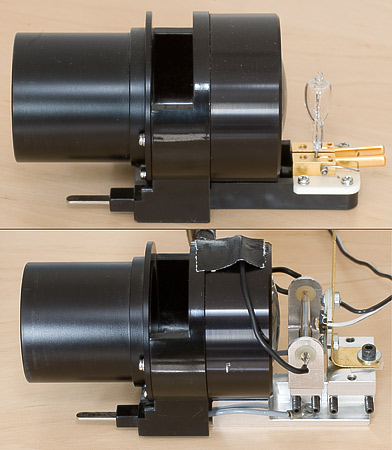
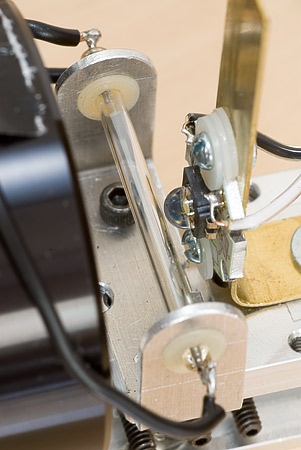
This is the "control box" that varies the flash out put in 1/2 stop increments over a range of 8 stops. I never use TTL auto-flash, always manual. The mouse has been wired directly to my camera remote jack. I just use the right and left buttons. Right mouse button is like a "partial shutter press", left mouse button is full shutter release.
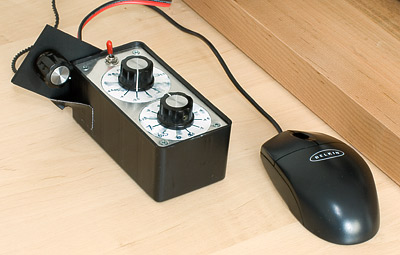
I've used this for over 9 years without a problem.
Other methods that have worked well involved a 45 degree glass placed above the base light port with a flash directed into it from the side. Some of the flash illumination was thus reflected upward, while sufficient light came through from the base to provide for viewing and focus. This is pretty easy to set up. You can use plain glass, semi-silvered mirrors, or other types of beamsplitters. ( I actually used a very thin pellicle mirror... no chance of "ghosting" but only because I was able to snag one at the right price on Ebay. At one time I also used a plain 2x3" glass slide!)
Once I had a set-up using a bifurcated ("Y" shaped) fiber optic light guide with a microscope where the bulb was plugged into the the rear of the stand. I placed one arm of the "Y" into a fiber optic illuminator, and the other up against the flash tube of an electronic flash. The microscope bulb was removed, and the single, common end of the light guide was placed at the bulb location. This worked surprisingly well. (The more "randomized" the light guide the better).
Keep in mind that for flash to be really useful you will need a trinocular head that permits a "split" between the viewing eyepieces and the camera trinocular tube. You also need to pay attention to the continuous light used for viewing and focusing. When taking a flash picture the continuous light level should be low enough so that it does not add to the image (use the fastest flash sync speed your camera allows). Easily checked by taking an image with the flash turned off. This is pretty easy to do and you will still have sufficient continuous light to comfortably see what you are doing.
Re: Tube-dwelling diatoms
Posted: Wed Jul 06, 2016 7:52 am
by vasselle
Bonjour
Superbes photos j'adore.
Cordialement seb
Re: Tube-dwelling diatoms
Posted: Thu Jul 07, 2016 12:02 pm
by gekko
Incredible images. Thank you, Charles, for sharing them with us on this forum.
Re: Tube-dwelling diatoms
Posted: Thu Jul 07, 2016 1:12 pm
by McConkey
Thanks for taking the time to show and explain your various flash methods! I'll keep an eye out for an extra lamphouse for my setup!
Re: Tube-dwelling diatoms
Posted: Thu Jul 07, 2016 3:45 pm
by apochronaut
The craft and care you put into your images, Charles, are always remarkable, as well as the images , themselves. Thank you for sharing them with the forum.
 ) Seeing the interest in diatoms here, I revisited that photo session from last summer and worked up some new (albeit similar) images. These are a marine species collected in Puget Sound WA. (47.589868° -122.379828°)
) Seeing the interest in diatoms here, I revisited that photo session from last summer and worked up some new (albeit similar) images. These are a marine species collected in Puget Sound WA. (47.589868° -122.379828°)











